Protecting Natural Resources: Long-Term Monitoring in Acadia National Park
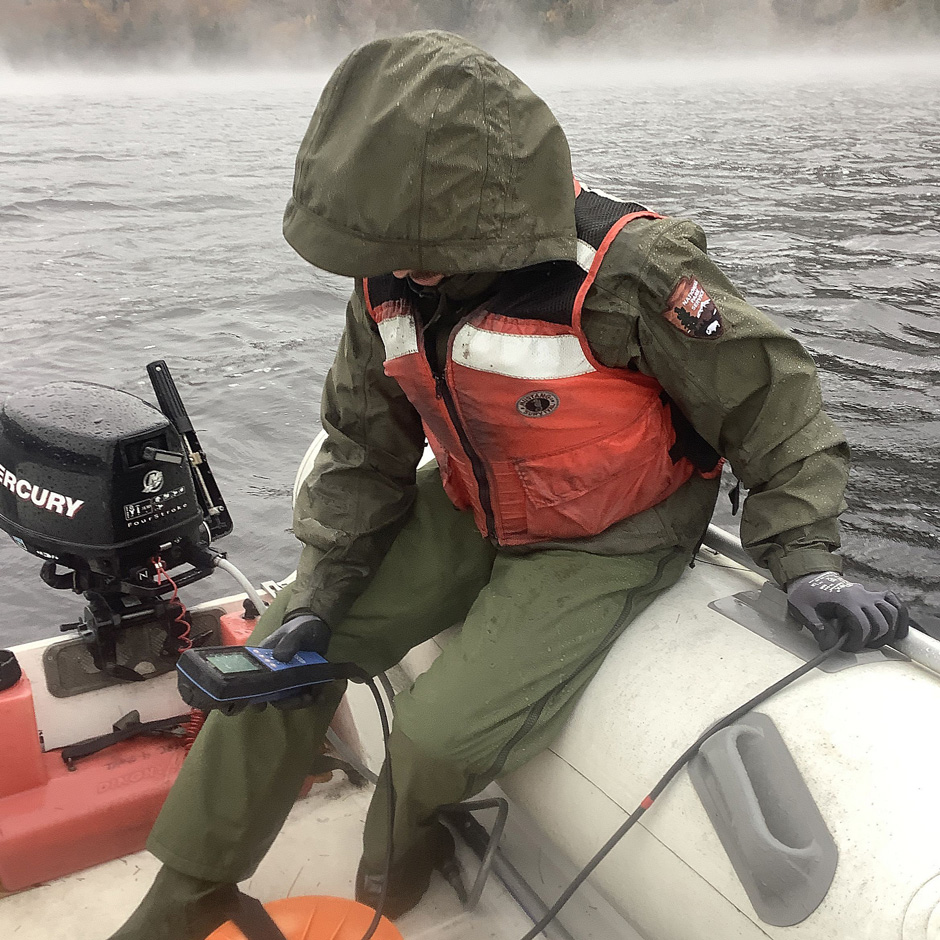 Acadia NP Biological Technician Jake Van Gorder collects a water quality data profile using a YSI EXO1 sonde during a monthly lake monitoring visit. (Credit: Kathleen Brown/NPS)
Acadia NP Biological Technician Jake Van Gorder collects a water quality data profile using a YSI EXO1 sonde during a monthly lake monitoring visit. (Credit: Kathleen Brown/NPS)The United States’ national parks are visited by millions of people each year, providing opportunities to experience the local beauty of the U.S. A core mission of the National Park Service (NPS) is to protect and preserve these unique areas since they are not totally free of pollution and the influence of climate change.
As such, national parks are the site of many environmental monitoring programs designed to assess the effects of global stressors like climate change and pollution on park resources. Acadia National Park’s water and air monitoring programs are examples of this, providing a long-term data history documenting changes in air and water quality over the past four decades.
Bill Gawley, a biologist at Acadia National Park for the past 30 years, manages the park’s air and water resource programs. Over his time at the park, Gawley has seen the program develop over the years, becoming more comprehensive as time goes on.
Acadia National Park Monitoring Efforts
Acadia was created with the intention of preserving and protecting the region’s natural and cultural resources. The scenic mountains, near-pristine water resources, and good air quality of Acadia are also major drivers of tourism to the national park, making protecting these resources important.
Gawley explains this responsibility, “As federal land managers, that’s why we’re here—to both protect the resources and also keep them accessible for the public to enjoy.” He continues, “We have long-standing monitoring programs for both air and water resources that help us track our progress.”
Thanks to this long-term pool of data, scientists at the national park have been able to detect the subtle changes the resources have undergone as a result of climate change and pollution, as well as how environmental policies have impacted the pollution influencing the park.
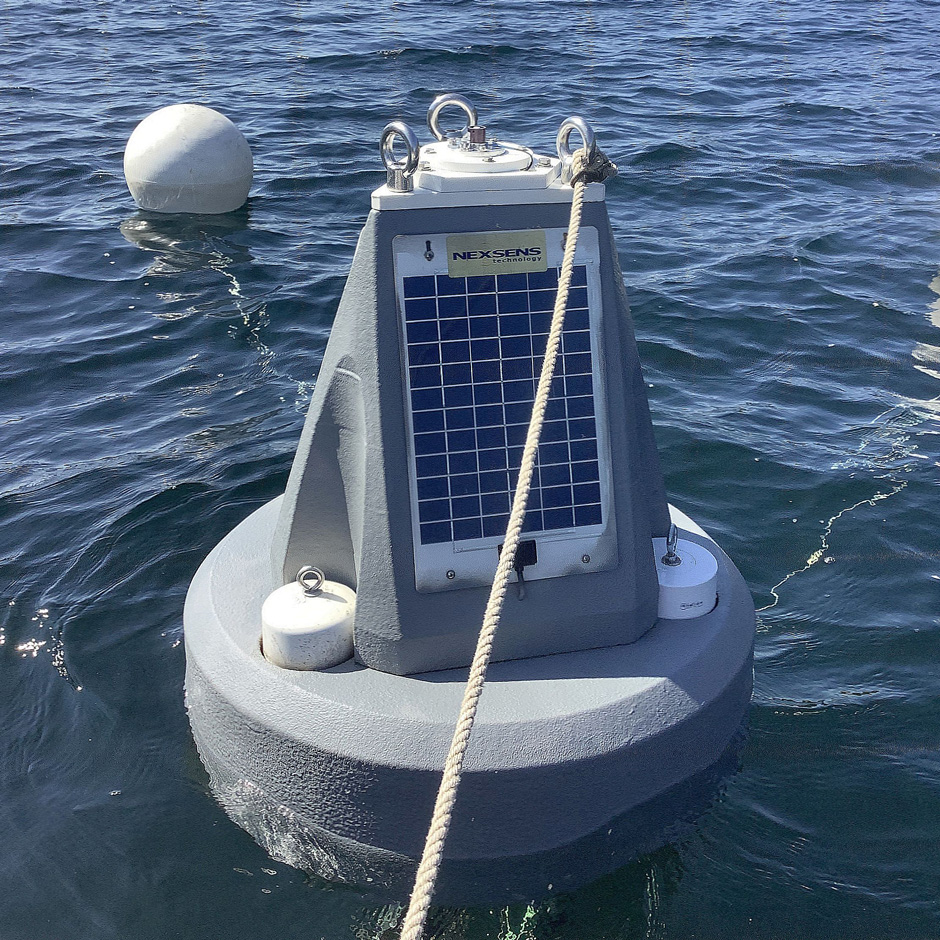
The NexSens CB-400S high-resolution monitoring buoy that has been deployed seasonally in Jordan Pond since 2013. The buoy was repainted from its original yellow hull color to make it more unobtrusive in a popular location for scenic photographs. (Credit: Jake Van Gorder/NPS)
In addition to climate change, one of the most significant stressors to water resources, according to Gawley, is air pollution, particularly acid deposition in the form of acidic rain, snow, and fog. Acadia monitors both air and water conditions in order to understand how changing conditions shape the park.
Gawley expands, “We’re lucky that we can monitor the stressors, like precipitation pH at our air monitoring station as well as the water quality of park lakes and streams—so we can assess both the level of pollution that’s coming in, and also the effect that it is having on the water. Studies conducted in a lot of other places don’t have the luxury of being able to collect both those datasets in the same location.”
The NPS Air Resources Division has established a comprehensive air quality monitoring strategy across the national park system to determine the influence of air quality on human health, ecological systems, and visitor experience. Levels of four general pollutant types are tracked at Acadia’s air monitoring station through participation in several national air quality monitoring programs.
Gaseous pollutants like ozone are present in both remote and urban areas and can have harmful effects on both human and ecosystem health. Ozone and its precursor gases are continuously monitored at Acadia in collaboration with the Maine Department of Environmental Protection (MDEP), who use the data to track compliance with national air quality standards and provide forecasts and advisories when ozone reaches unhealthy levels.
Atmospheric deposition is measured by analyzing weekly precipitation samples for concentrations of acidic compounds and mercury, both of which can affect terrestrial and aquatic systems and their inhabitants. Particles in the air affect human respiratory health and degrade visibility. Collaborative particulate monitoring with MDEP provides information on both issues.
“The MDEP monitors levels of fine particles affecting human health, and issues forecasts and advisories similar to those provided for ozone. The Park Service is especially interested in understanding the effects of particulate levels on visibility because over 3 million people come to the park every year wanting to be able to clearly see all these spectacular views and resources,” states Gawley.
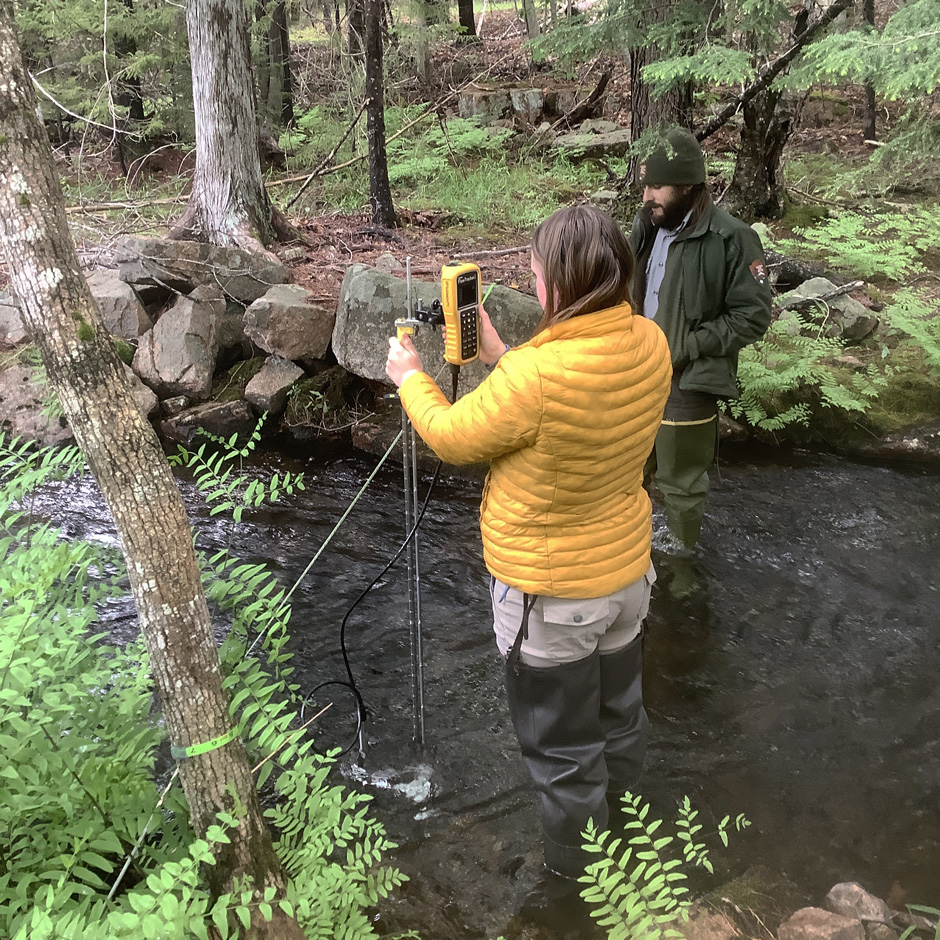
Acadia NP Biologist Kathleen Brown and Biological Technician Jake Van Gorder measure streamflow during a monthly stream monitoring visit. (Credit: Bill Gawley/NPS)
Multifaceted Monitoring
In addition to the year-round, continuous air quality monitoring occurring in the park, Gawley coordinates and implements water quality and quantity monitoring in Acadia’s lakes and streams. Eleven lakes and eleven streams are monitored monthly from May through October using protocols developed by the Northeast Temperate Network (NETN), one of the 32 networks in the NPS Inventory and Monitoring Program. Additionally, a high-resolution monitoring buoy has been deployed for the past ten years in Jordan Pond, one of Acadia’s most iconic aquatic resources.
As the primary author of NETN’s water monitoring protocol, Gawley spends part of his time working to support monitoring efforts at eight other parks—located from New Jersey to Vermont— in the NETN. Locally, Gawley works closely with those who live and work on the surrounding lands to understand and protect Acadia’s water resources.
Gawley explains, “Acadia is a very fragmented park—it’s not just one contiguous area. There are a lot of private inholdings because it was largely established through donated land. It’s kind of a mosaic, in some ways, of private and federally owned land. There’s a lot of stakeholders and there’s a lot of neighbors.”
Six lakes in the park are sources of municipal drinking water for nearby communities, and their water quality is considered to be so pristine that the municipal water companies have been granted filtration waivers by the U. S. Environmental Protection Agency (EPA). These lakes require enhanced stewardship and protection and park efforts, in tandem with those of the water companies, have been very effective toward achieving that goal.
The park has many trails, carriage roads, boat launch ramps, and other infrastructure that border water resources, and park staff and contractors performing maintenance and construction activities must exercise caution to avoid unintended impacts.
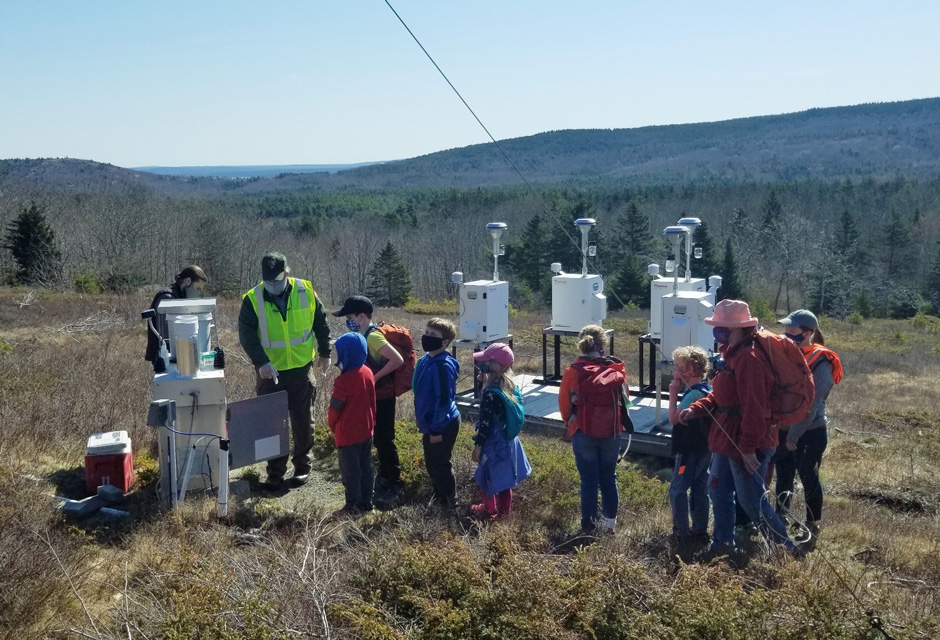
Acadia NP Biological Technician Jake Van Gorder and Air-Water Program Manager Bill Gawley demonstrate the operation of a precipitation sampler to a group of homeschoolers during their visit to the park’s air quality monitoring station. (Credit: David Burks)
“We’ve got a responsibility to take care of our own backyard and to look after our neighbors. So we work carefully in the planning of construction and rehabilitation projects to make sure that best management practices are followed to protect the resources and often employ monitoring plans to measure their effectiveness,” elaborates Gawley.
Acadia has been monitoring its air and water resources for decades—gathering data that has supported research focusing on the influence of climate change and other environmental stressors on relatively isolated water bodies that are less affected by residential development and other high-impact adjacent land uses.
“The long baseline data history is very attractive for people that already recognize the trends of some of our water quality parameters, and they want to focus on a very specific research question. We encourage and facilitate a lot of that research, and it, in turn, helps us solve a lot of our park management problems,” states Gawley.
Environmental Concerns in Acadia National Park
Since the 1980s, most of Acadia’s lakes have experienced declines in water transparency, and a looming threat of harmful algal blooms occurring elsewhere in the region has made resource managers wary. Most of the transparency changes have been attributed to increases in dissolved organic carbon in the water, which can cause the browning of the water and reduce transparency.
Virtually all of Acadia’s historic water quality data were collected during monthly, or in some cases annual monitoring events, providing only “snapshots” of conditions during those specific visits. Park resource managers and cooperating researchers were eager for higher resolution data to fill in the gaps on the range of variability between the discrete monitoring visits and how water quality responded to storms and other high-intensity, episodic events. By 2013, planning was underway for the deployment of a buoy system to support continuous lake water monitoring.
Jordan Pond was chosen as the monitoring site due to its exceptional clarity and relatively low algal productivity. The low-ionic strength water allowed the detection of trace levels of chemical constituents and small incremental changes. Jordan Pond is also the deepest lake in the park, providing good spatial data for lake stratification studies.
“We thought, with Jordan Pond being such a clear lake and being able to detect such small changes, that it would be good to really look at the daily cycling of dissolved organic matter in the lake,” Gawley expands.
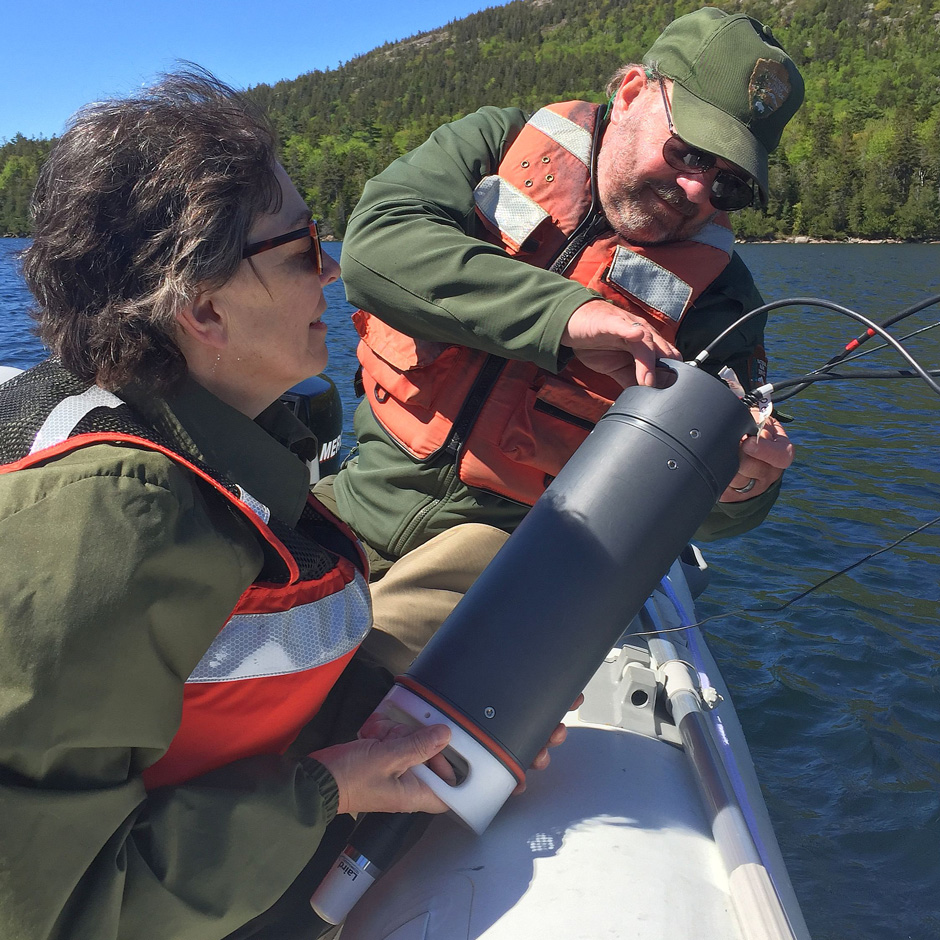
Acadia NP Resource Management Lead Rebecca Cole-Will and Air-Water Program Manager Bill Gawley prepare to install the NexSens SDL500 datalogger in the Jordan Pond high-resolution monitoring buoy. (Credit: Judy Hazen Connery/NPS)
In order to monitor the conditions connected to browning and other water quality changes, a NexSens data buoy equipped with a YSI EXO2 sonde is deployed on the lake. The sonde monitors fluorescent dissolved organic matter as a surrogate for dissolved organic carbon, dissolved oxygen, temperature, specific conductance, pH, and total algae (chlorophyll A and phycocyanin).
Data from the buoy sensors are transmitted by radio signal to a base station at the Jordan Pond House, a park concession restaurant at the south end of the lake. The base station also receives data from a weather station located on the restaurant roof, which helps tie various meteorological events to changes in the lake. The combined sensors help link the cause and effect of changes in lake conditions, including algal productivity—something that Gawley explains to be of growing concern.
He elaborates, “We’ve been pretty isolated from having harmful algal blooms (HABs) this far north in Maine, but in the past several years they seem to be occurring a little more frequently, and in lakes that have been considered less susceptible to them.” He continues, “We’re a little concerned that this might be an issue that we’re going to have to deal with more in the near future.”
A Monitoring Program Sponsored by Friends
Acadia is one of the most highly visited national parks, and the high traffic introduces unique challenges and opportunities to the staff there. While many park resources are isolated from a lot of manmade influence, the park relies heavily on the stewardship of visitors and local residents to help keep the park and its resources pristine.
The high visitation presents rangers and scientists with a plethora of opportunities to educate the public about the park’s resources and the importance of practices like “Leave No Trace.” At the same time, high traffic can make it difficult for scientists to reach the resources to efficiently monitor the lake when boat ramps are blocked or parking lots are full.
Still, Gawley explains that these complications allow for more opportunities to connect with the public, saying, “We get a chance to provide some good outreach and messaging while we’re questioned by visitors as we’re preparing to head out for a monitoring trip. It often takes a few extra minutes of our time, but it’s all for good results.”
While the park has a long history of conducting their own monitoring activities, the key to the program’s success is through working collaboratively with a wide range of local, state, and federal groups and academic institutions. Gawley summarizes, “there are an awful lot of people looking for the same answers we are, and we’re far more effective when we work together— we’re all on the same team.”
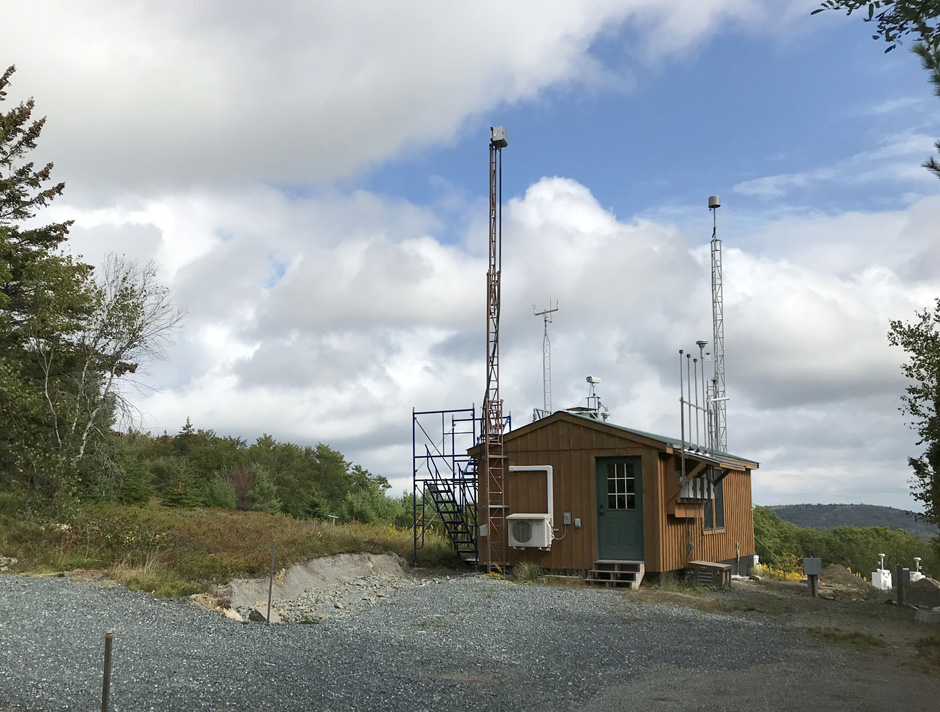
The Acadia NP air quality monitoring station has been collecting data on gaseous pollutants, atmospheric deposition, and particulates and visibility effects for over four decades. (Credit: Bill Gawley/NPS)
Friends of Acadia has been a key partner in sponsoring the development of the Jordan Pond monitoring system and the upkeep of the natural resources.
Gawley elaborates, “Friends of Acadia has a long history of fundraising and advocacy efforts for us, and they’ve contributed millions of dollars over the years to different park projects like carriage road restoration and trail restoration, and the Island Explorer bus system.”
The group also began the Wild Acadia initiative to look more closely at the park’s natural resources, including Jordan Pond. The initial proposal included the purchase of the NexSens buoy, which was paid in part by a grant from Canon, USA. The team of scientists at Acadia then relied on the expertise of colleagues at the University of Maine Climate Change Institute and NexSens engineers to help design and deploy the buoy, which has been gathering data for almost a decade.
“We’ve been able to get a good, steady data capture. And we’ve been fortunate enough to start to see what’s happening in those time spans in between our monitoring visits and get a better idea of the really subtle changes that are happening in the lake,” states Gawley.
Conclusion
The long-term monitoring programs in Acadia also allow researchers within and outside of the park to assess how policy changes have influenced the environment. For example, many air and water monitoring efforts in the park began around the time of the establishment of the Clean Air Act (CAA). The following decades of data from these efforts show improvements in air quality resulting from CAA emission reductions that have, in turn, contributed to improved water quality.
Those observations reveal just how impactful the legislation has been—Gawley explains, “It’s a good story to tell, and it provides a little bit of hope for the future. We’re in an era when there’s not always a lot of good news being communicated.”




Karen Boardman
October 10, 2024 at 10:40 am
What are the mini tents monitoring?
Samantha Baxter
October 10, 2024 at 3:00 pm
What do you mean by “mini tents”?